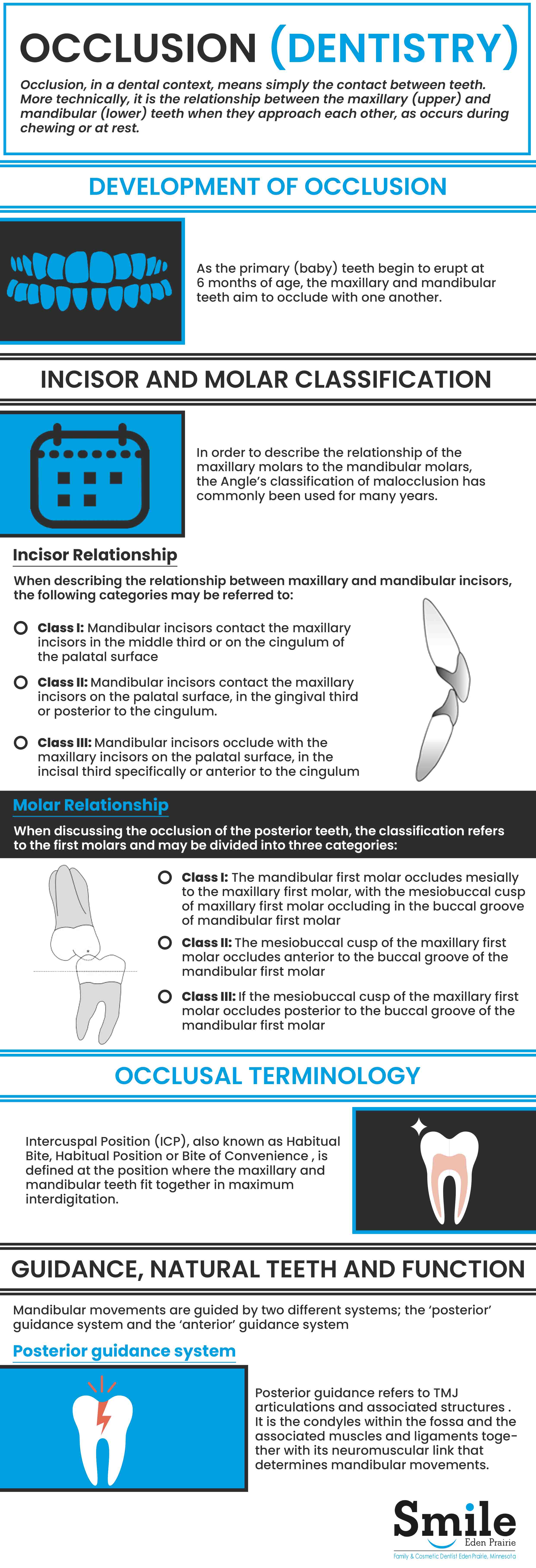General Dentistry Concepts: Occlusion
Occlusion within dentistry refers to the contact between teeth. In more technical terms, it is the relationship between the maxillary or upper and mandibular or lower teeth. This can occur when they approach each other which happens when chewing or at rest. There are two types of occlusion, static and dynamic. Static occlusion is the contact between teeth when the jaw is closed and not moving. Dynamic occlusion occurs when the jaw is moving.
Development of occlusion
As the primary or baby teeth begin to erupt around 6 months of age, the upper and lower teeth work to occlude with one another. The erupting teeth then mold into position by the tongue, cheeks and lips during development. The upper and lower primary teeth should be correctly occluding and aligned after two years of age while they are continuing to develop. Full root development is typically complete at three years of age.
About a year after the development of the teeth is complete, the jaws continue to grow. This results in the spacing between some of the teeth which is also called diastema. This impacts the anterior or front teeth the most and is noticeable when children are four to five years old. This spacing is critical because it makes space for the eruption of the permanent teeth and the correct occlusion. Without proper spacing there will be crowding of the permanent teeth.
In order to understand the development of occlusion and malocclusion, it is important to first understand the premolar dynamics. The permanent premolars usually erupt when a child is between 9 and 12 years old. The permanent premolars replace the primary molars. The erupting premolars are smaller than the teeth they replace. This allows the permanent molars to erupt and helps develop normal alignment.
Incisor Relationship
When describing the relationship between the maxillary and mandibular incisors, the following categories are commonly used:
- Class I: Mandibular incisors contact the maxillary incisors in the middle third or on the cingulum of the palatal surface
- Class II: Mandibular incisors contact the maxillary incisors on the palatal surface, in the gingival third or posterior to the cingulum. This is further subdivided into division I and II:
- Division I: includes maxillary incisors which are proclined (90%) and these individuals have a greater horizontal overlap
- Division II: includes those with retroclined (10%) incisors, which leads to an increase in an overbite or vertical overlap
- Class III: Mandibular incisors occlude with the maxillary incisors on the palatal surface, in the incisal third specifically or anterior to the cingulum
When reviewing the occlusion of the posterior teeth, the classification system used refers to the first molars and is divided into three different categories which include:
- Class I: The mandibular first molar occludes mesially to the maxillary first molar, with the mesiobuccal cusp of maxillary first molar occluding in the buccal groove of mandibular first molar
- Class II: The mesiobuccal cusp of the maxillary first molar occludes anterior to the buccal groove of the mandibular first molar
- Class III: If the mesiobuccal cusp of the maxillary first molar occludes posterior to the buccal groove of the mandibular first molar
The classification of occlusion and malocclusion play a critical role in the diagnosis and orthodontic treatment.

